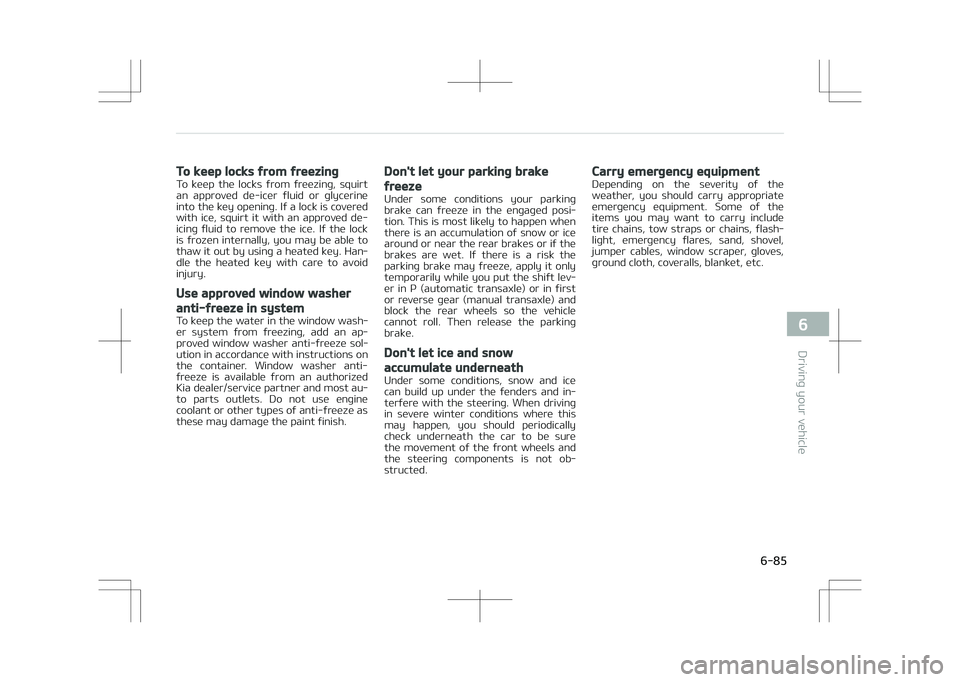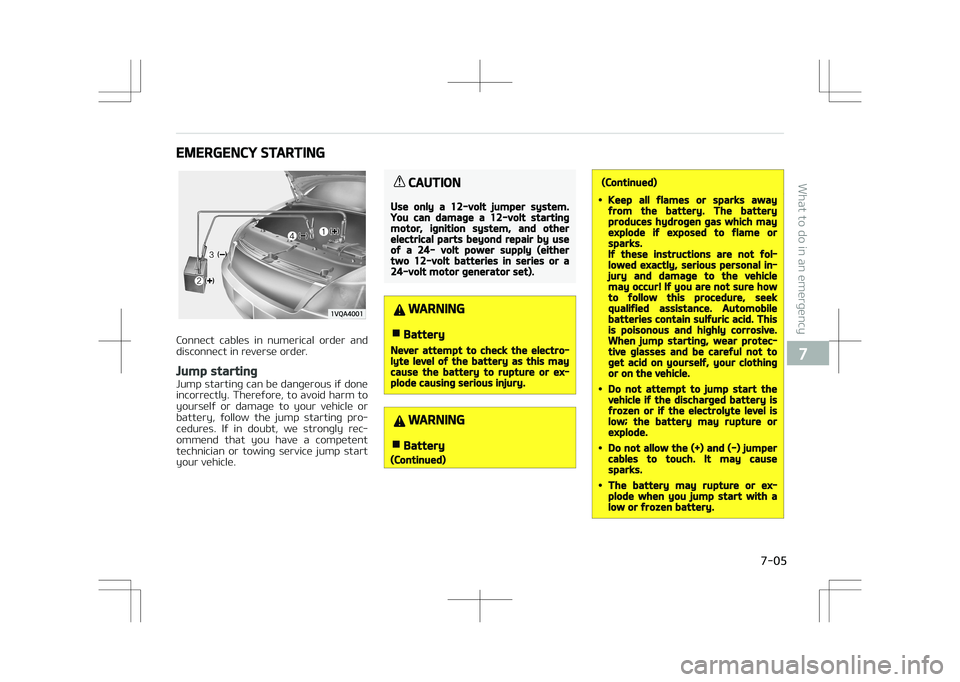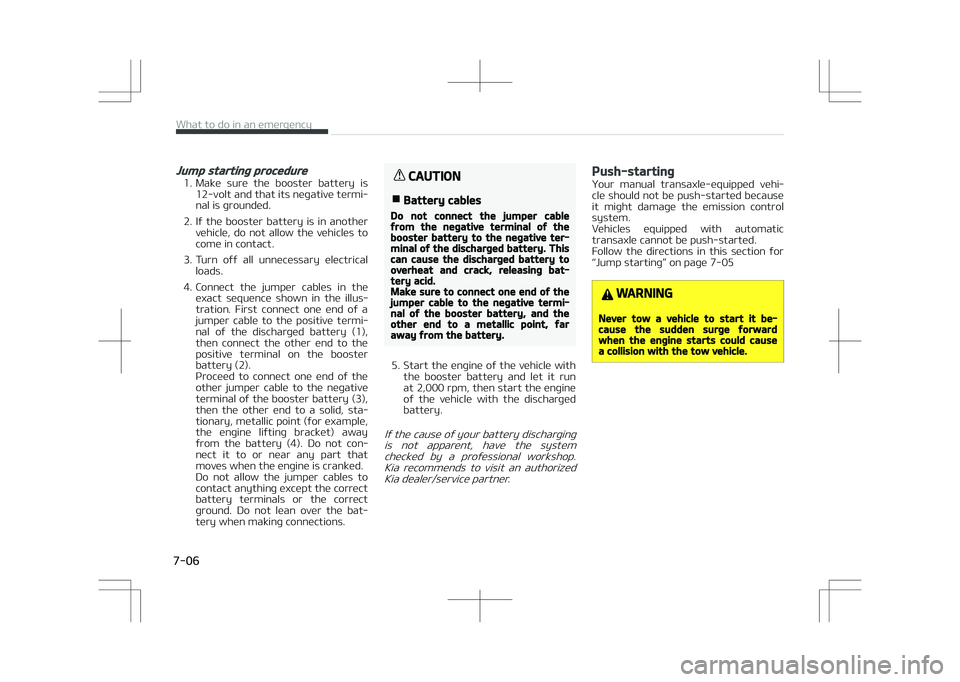jump cable KIA STONIC 2018 Owners Manual
[x] Cancel search | Manufacturer: KIA, Model Year: 2018, Model line: STONIC, Model: KIA STONIC 2018Pages: 523, PDF Size: 24.99 MB
Page 307 of 523

To keep locks from freezing
To keep the locks from freezing, squirt
an approved de-icer fluid or glycerine
into the key opening. If a lock is covered with ice, squirt it with an approved de-
icing fluid to remove the ice. If the lock
is frozen internally, you may be able to thaw it out by using a heated key. Han‐
dle the heated key with care to avoid
injury.
Use approved window washer
anti-freeze in system
To keep the water in the window wash‐
er system from freezing, add an ap‐ proved window washer anti-freeze sol‐
ution in accordance with instructions on
the container. Window washer anti- freeze is available from an authorized
Kia dealer/service partner and most au‐
to parts outlets. Do not use engine
coolant or other types of anti-freeze asthese may damage the paint finish.
Don't let your parking brake
freeze
Under some conditions your parking brake can freeze in the engaged posi‐
tion. This is most likely to happen when
there is an accumulation of snow or ice around or near the rear brakes or if the
brakes are wet. If there is a risk the
parking brake may freeze, apply it only temporarily while you put the shift lev‐
er in P (automatic transaxle) or in first
or reverse gear (manual transaxle) and block the rear wheels so the vehicle
cannot roll. Then release the parking
brake.
Don't let ice and snow
accumulate underneath
Under some conditions, snow and ice
can build up under the fenders and in‐ terfere with the steering. When driving
in severe winter conditions where this
may happen, you should periodically check underneath the car to be sure
the movement of the front wheels and
the steering components is not ob‐ structed.
Carry emergency equipment
Depending on the severity of the
weather, you should carry appropriate
emergency equipment. Some of the items you may want to carry include
tire chains, tow straps or chains, flash‐
light, emergency flares, sand, shovel, jumper cables, window scraper, gloves,
ground cloth, coveralls, blanket, etc.
6-85
6
Driving your vehicle
Page 321 of 523

EMERGENCY STARTING
Connect cables in numerical order and
disconnect in reverse order.
Jump starting
Jump starting can be dangerous if done
incorrectly. Therefore, to avoid harm to yourself or damage to your vehicle or
battery, follow the jump starting pro‐
cedures. If in doubt, we strongly rec‐ ommend that you have a competent
technician or towing service jump start
your vehicle.
CAUTION
Use only a 12-volt jumper system.You can damage a 12-volt startingmotor, ignition system, and otherelectrical parts beyond repair by useof a 24- volt power supply (eithertwo 12-volt batteries in series or a24-volt motor generator set).
WARNING
nBattery
Never attempt to check the electro‐lyte level of the battery as this maycause the battery to rupture or ex‐plode causing serious injury.
WARNING
nBattery
(Continued)
(Continued)
•Keep all flames or sparks awayfrom the battery. The batteryproduces hydrogen gas which mayexplode if exposed to flame orsparks.If these instructions are not fol‐lowed exactly, serious personal in‐jury and damage to the vehiclemay occur! If you are not sure howto follow this procedure, seekqualified assistance. Automobilebatteries contain sulfuric acid. Thisis poisonous and highly corrosive.When jump starting, wear protec‐tive glasses and be careful not toget acid on yourself, your clothingor on the vehicle.
•Do not attempt to jump start thevehicle if the discharged battery isfrozen or if the electrolyte level islow; the battery may rupture orexplode.
•Do not allow the (+) and (-) jumpercables to touch. It may causesparks.
•The battery may rupture or ex‐plode when you jump start with alow or frozen battery.
7-05
7
What to do in an emergency
Page 322 of 523

Jump starting procedure
1. Make sure the booster battery is12-volt and that its negative termi‐ nal is grounded.
2. If the booster battery is in another vehicle, do not allow the vehicles to
come in contact.
3. Turn off all unnecessary electrical loads.
4. Connect the jumper cables in the exact sequence shown in the illus‐
tration. First connect one end of a
jumper cable to the positive termi‐
nal of the discharged battery (1),
then connect the other end to the
positive terminal on the booster
battery (2).
Proceed to connect one end of the other jumper cable to the negative
terminal of the booster battery (3),
then the other end to a solid, sta‐
tionary, metallic point (for example,
the engine lifting bracket) away
from the battery (4). Do not con‐
nect it to or near any part that
moves when the engine is cranked.
Do not allow the jumper cables to
contact anything except the correct
battery terminals or the correct
ground. Do not lean over the bat‐ tery when making connections.CAUTION
nBattery cables
Do not connect the jumper cablefrom the negative terminal of thebooster battery to the negative ter‐minal of the discharged battery. Thiscan cause the discharged battery tooverheat and crack, releasing bat‐tery acid.Make sure to connect one end of thejumper cable to the negative termi‐nal of the booster battery, and theother end to a metallic point, faraway from the battery.
5. Start the engine of the vehicle with the booster battery and let it run
at 2,000 rpm, then start the engine
of the vehicle with the discharged
battery.
If the cause of your battery discharging
is not apparent, have the systemchecked by a professional workshop.Kia recommends to visit an authorized Kia dealer/service partner.
Push-starting
Your manual transaxle-equipped vehi‐
cle should not be push-started because it might damage the emission control
system.
Vehicles equipped with automatic
transaxle cannot be push-started.
Follow the directions in this section for L